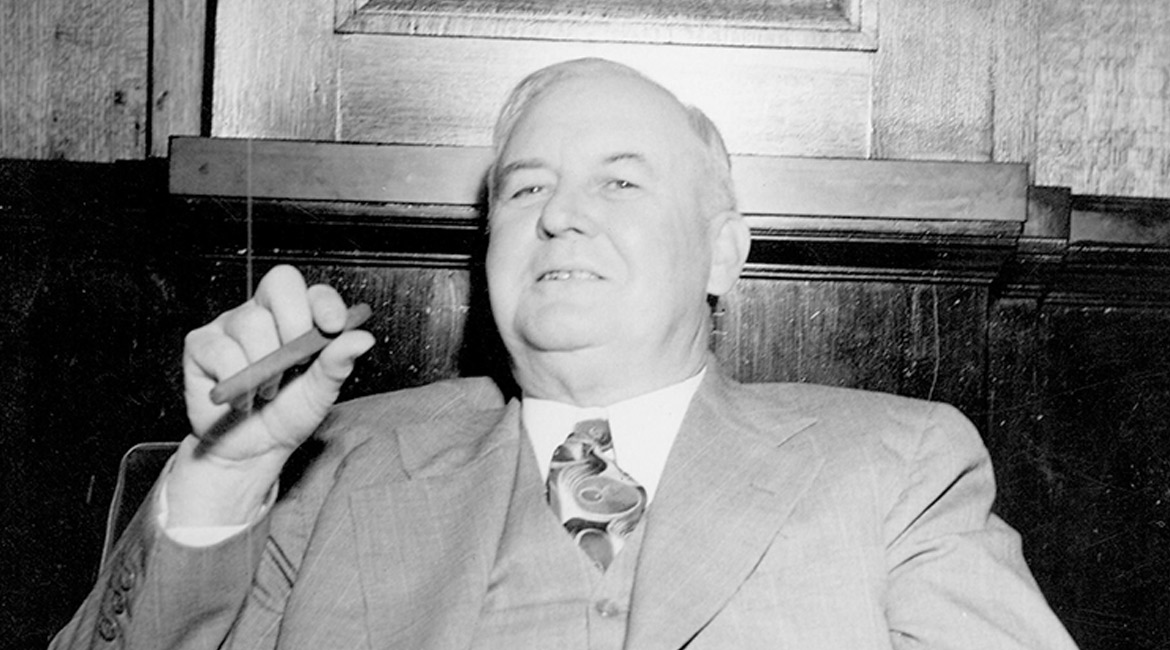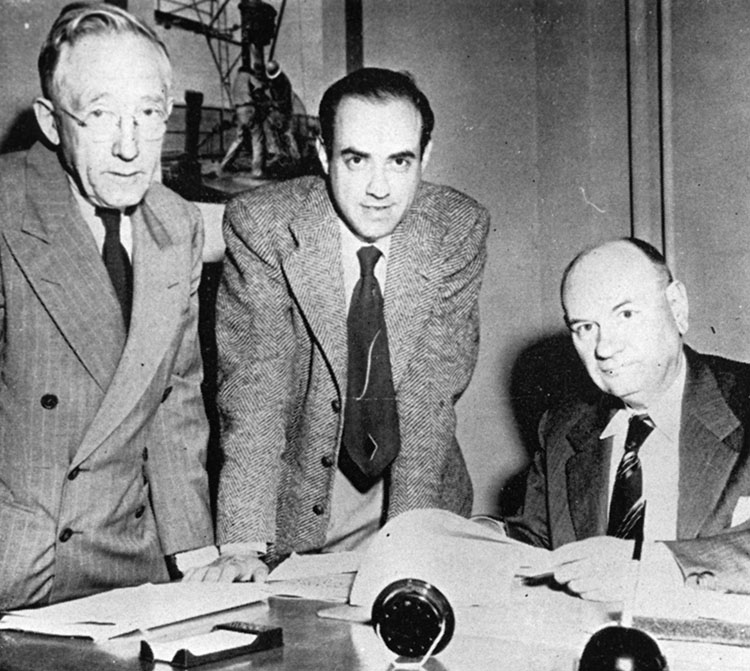
Loyal and True
Tuesday, May 1, 2018
Red Scare Comes to Orange County
By David Peters
In March 1951, the Oklahoma Legislature mandated that all state employees sign a new Oath of Allegiance (Loyalty Oath) or they would lose their jobs.
The signing deadline was May 9, 1951. All Oklahoma A&M College staff members were required to sign, even part-time student workers, swearing they would defend the U.S. Constitution and the Oklahoma Constitution, even by force if necessary. They also swore that they were not members of the Communist Party, had not joined a communist front organization during the previous five years, and met other provisions in the oath, which ran over 450 words.
Oklahoma’s attorney general and governor led a resistance-type movement to this oath, an unusual collection of alliances that pitted friends against each other, united political adversaries, forced authorities to defend legal statutes they believed were unlawful and compelled attorneys to appeal court decisions that had pleased their clients.
Events surrounding World War II had raised concerns among Oklahoma residents about the growing influence of communism around the world. They had witnessed the rise of the Soviet Union and seen its expanding influence in Eastern Europe. At the national level, President Harry Truman signed an executive order in 1947 to form the “Federal Employees Loyalty Program.” Review boards examined “un-American” and communist activities and could recommend the removal of government employees suspected of involvement with communist infiltrators.
By 1949, the Soviets had successfully tested an atomic bomb, and communists in China had taken control of the mainland. The Oklahoma Legislature determined it was time to begin fighting the enemies of the United States, especially on the domestic front. The Oklahoma House of Representatives appointed a five-member special committee to investigate communism in Oklahoma colleges and universities. It required a signed oath from every college president regarding “communistic activities, if any, on the part of deans and heads of departments.”
In June 1950, the Soviets and Chinese supported North Korea’s invasion into South Korea, and the Oklahoma Legislature sprang into action once again. The American Legion in Oklahoma supported and encouraged the legislature and helped develop a loyalty oath to weed out any communist influences in state agencies.
The loyalty oath proposal passed unanimously in March 1951 with a deadline for all state employees’ signatures within two months. Governor Johnston Murray was advised that portions of the Loyalty Oath were unconstitutional. Oklahoma Attorney General Mac Williamson, University of Oklahoma President George Cross and the university’s professor of constitutional law all counseled the governor that the proposed oath had significant constitutional flaws.
Murray buckled under the prevailing political pressure, fearing being labeled soft on communism, and signed the bill while publicly acknowledging that parts of it were unconstitutional.
Implementing the new law would become a logistical challenge for the two largest public universities in Oklahoma. For some college employees in Stillwater, it would become a crisis of conscience. The university administration had remained relatively mute. By 1951, Dr. Henry G. Bennett was leading the Point Four Program out of Washington, D.C., and the acting college president, Dr. Oliver S. Willham, kept a low profile during the oath signing implementation. One of Willham’s few public comments concluded with, “It is just another law, and as such we must honor it.” This was a muted response compared with the comments from Regent and former Chairman Colonel R.T. Stuart, who stated: “Any man who opposed the bill is nothing but a damned Communist,” and anyone “who does not sign the oath is out.”

The distribution and collection of signed loyalty oaths across campus proceeded fairly smoothly at first. The vast majority signed because they either agreed with the oath or feared losing their jobs.
Initially, several dozen full-time employees were not going to sign the oaths, but they decided to sign and cross out the portions that they found objectionable. There was a resurgence of the campus chapter of the American Association of University Professors. AAUP officers were elected, and an open forum drew 100.
Meanwhile, efforts were underway to clarify the law and its consequences. Fred Hansen, first assistant attorney general, listed 11 points of potential constitutional conflict in the original legislative bill or in the oath. His letter to Murray concluded the law did not prohibit or remove any elected or appointed person who had not signed the oath from their public office. All other state employees, however, would be required to sign.
As the May 9th deadline approached, some employees were forced from their jobs. Seven student workers were terminated while five faculty members on sabbatical leave were given a 30-day waiver. Thirty-nine faculty, staff and students signed but included a variety of objections. A few others who did not sign were allowed to resign.
Some signers were not U.S. citizens. They had been in contact with their embassies and advised in a variety of different ways to respond. Some signed but stated they were a citizen of another country; others crossed out portions of the oath that might jeopardize or conflict with their citizenship at home. Frank and Gillian Bonsall of Great Britain were visiting professors in a Fulbright exchange program. The British embassy advised them not to sign; they pleaded their case to the college president on May 11th and lost. Although their federal contract and funding went through the end of June when they had planned to return home, they were not paid for the final six weeks on their contract and left early.
As the deadline for signing drew near, a new actor in the oath drama entered the scene. Paul W. Updegraff, a Norman attorney, requested a court injunction against state officials and the A&M Board of Regents to stop them from paying those employees who had not complied.
Updegraff claimed that if the oath law was not enforced, it would be “opening our colleges to Reds and people from foreign lands with foreign ideologies.” He fanned the flames of fear. On May 19, 1951, District Court Judge W.A. Carlisle ruled that the law and oath were constitutional, salaries would cease immediately, and non-complying employees would be fired. The ruling only applied to OAMC employees. Ten tenure-track faculty members were dismissed.
After Carlisle’s ruling, the attorney general met with the board on May 20th to discuss the consequences of their victory. Although classes were still in session for the spring semester, final exams were canceled for some affected classes, and grades were determined based on student performances to that date. Research efforts and laboratory access were halted for individuals who had been fired. The use of federal funds supporting the Fulbright exchanges were now in jeopardy, as were sources of other federal support. The Fulbright Act was intended to promote goodwill and encourage international exchanges among academic institutions worldwide, and the college’s future participation was in danger. Williamson, the attorney general, stated, “Federal interests are directly involved and adversely affected.”
OAMC Vice President Randall T. Klemme reported a number of federal military research contracts were also at risk. The U.S. Navy research contract with the Mathematics Department was in serious danger of being transferred elsewhere. Federal funds invested in the college exceeded $400,000 a year for these projects. This did not include federal funds from the Hatch and Smith-Lever Acts for the agricultural experiment station and extension services. Williamson encouraged the regents to request clarification from Carlisle to allow existing federal contracts to be completed. The judge denied the request, and they began preparing for an appeal.
Affected faculty members began looking for — and landing — academic positions elsewhere.
In October 1951, the regents and eight fired employees appealed Carlisle’s ruling to the Supreme Court of Oklahoma but lost. The case was appealed to the U.S. Supreme Court. The high court ruled that the oath violated the U.S. Constitution’s due process clause. The Oklahoma Legislature began revising the oath so that it would conform to the ruling.
On May 8, 1953, the regents agreed to pay 14 individuals the balances due them from their employment contracts, a total of $7,113.40. The regents offered no apologies.
Today, a signed loyalty oath continues to be required from all university employees before they are hired and entered into the payroll system.

